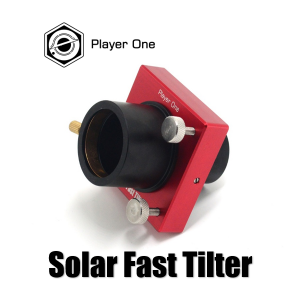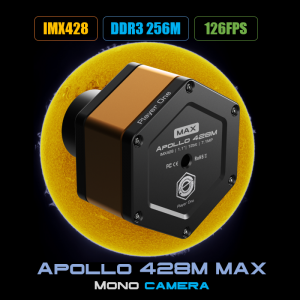The MaxFR Astronomik Filters photographic narrowband-emission line filters were designed for ultra-fast telescope optical systems as there is an ever growing demand for filters suitable for extremely fast optical systems like Celestron´s RASA and the Epsilon Astrographs made by Takahashi.

The MaxFR Astronomik Filters emission line filters are suitable up to very fast focal ratios and are perfectly matched to the requirements of astronomical deep-sky imaging with fast optical systems. For the three most important emission lines of oxygen (OIII), hydrogen (H-alpha) and sulfur (SII), buyers can select filters either with 12nm or 6nm Bandwidth (FWHM).
The new MaxFR filters are made in a completely new way, designed to work perfectly with fast optical systems. The built-in well known MFR Coating technique gives you the best out-of-band blocking possible across the entire range of wavelengths from the UV up to IR. The advantage of the new design is an extremely high contrast, minimized stray light, no halos and needle-sharp stars.
For 12nm MaxFR filters this means an unlimited usability from f/1.7 to f/8 and about 85% of the maximum transmission at a f/1:1.4 as guaranteed. For 6nm MaxFR filters this means an unlimited usability from f/2.2 to f/8 with about 90% of the maximum transmission at a f/2 as guaranteed performance data. For maximum contrast, the SII filter is carefully designed to block all light coming from H-alpha and NII (nitrogen).
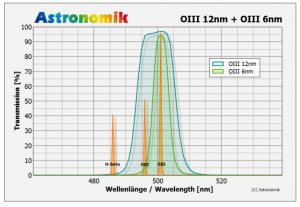
6nm and 12nm FWHM
If you have to observe from light polluted sites (like most of us…), imaging with narrowband-emission line filters is an excellent way to ensure great images, as they are so effective in blocking out light pollution.
An H-alpha filter is a great first step as you will be able to take deep and contrasty images even with very heavy light pollution or with the full moon – with H-alpha, nebulas are glowing red. An OIII filters expands your imaging possibilities, as you are able to image all greenish/blueish structures – planetary nebulas and star forming regions are great targets. The SII filters complete the set by only letting in the light of the ionized sulfur pass and blocks the rest of the visual spectrum.
Highlights of the new Astronomik MFR narrowband-emission line filters include:
– MFR Coating: The 12nm filters can be used on all instruments down to f/1.4, the 6nm filters down to f/2.
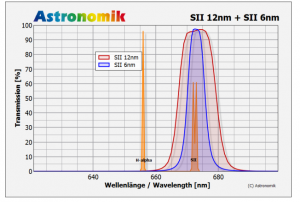
6nm and 12nm FWHM
– High-Quality substrate: Astronomik filters are made with stress- and striae free, optically polished glass. The filter itself is made of ultra-thin layers on this substrate.
– Parfocal filters: All Astronomik Filters are parfocal. Due to the very small thickness-tolerance the focal plane is not shifted when changing filters.
– Coating: Astronomik filters are made of up to 170 layers which are coated on both sides of the substrate. These layers form the filter itself and act as an anti-reflection coating.
– Durability: Due to the coating technique, all Astronomik filters are highly scratch resistant, not sensitive to moisture and do not degrade when getting older. Every Astronomik filter will deliver full performance and meet the specs at the point of shipping even after of years of service.
– Integrated Blocking: All unwanted light is blocked in the whole spectral range from UV up to the IR. (You will not need an additional UV & IR-Blocker when imaging with any of the new narrowband-emissionline filters with coating.)
– Wide range of available sizes from 1,25″ up to square 50mm x 50mm filters.
– Delivered in a high-quality protection & storage box.
– 10 year guarantee on all of filters.
Here are the Astronomik Team’s thoughts on what is the best full-width-half-maximum for a specific user:
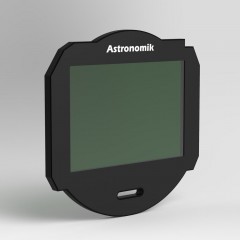
“The question which full-width-half-maximum (FWHM) is the “best”, shows up often in emails or when talking to customers at events. A general “right” or “wrong” or “best” does not make any sense. We would not offer both series if they were not needed.
If you have a camera with an extremely low dark current and effective cooling, the 6nm filters will give you major advantages. Due to the stronger blocking of the background you will be able to expose longer and get deeper images! All stars are very tiny points, most faint stars do not show up anymore. This is a major advantage even for normal cameras, as you can take images of faint structures even in star-crowded regions of the Milky Way.
To put it short: 12nm Filters are the right choice for all DSLRs and dark-current limited cameras. 6nm filters are the best choice for observing sites with extreme strong light pollution, cameras with low dark-current and when weak objects require the maximum contrast and star-reduction possible.”
As to the question on how much is exposure time increased, the Astronomik Team notes:
“This question is asked quite often, and the answer is very easy: You don’t have to expose longer, but you MAY expose longer!
Due to the high transmission of approximately 100% at the center wavelength nearly all emission line photons reach the sensor. So the number of, for example “H-alpha-photons”, does not change significantly whether an H-alpha filter is installed or not. But looking at the photons of other wavelength, which we do NOT want to record, makes the effect of the filter clear. The combination of a very good blocking of all unwanted light from UV up to the IR and the narrow bandwidth of the filters reduces all unwanted signal on the sensor.
If you do an exposure of 30sec without any filters from a light polluted urban observing site, your sky-background might already be very, very bright or even saturated. The same image taken with a Narrowband-Emission line filter will give you a perfect black background without any signal and the signal from the object will be about the same. With this black background you have the possibility to expose longer – probably 30min- to record fainter structures! So it’ś not a “must”, it´s a “can”.
To learn more about the MaxFR Astronomik Filters you can visit their website here.
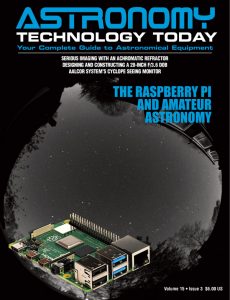 And to make it easier for you to get the most extensive news, articles and reviews that are only available in the magazine pages of Astronomy Technology Today, we are offering a 1 year magazine subscription for only $6! Or, for an even better deal, we are offering 2 years for only $9. Click here to get these deals which only will be available for a very limited time. You can also check out a free sample issue here.
And to make it easier for you to get the most extensive news, articles and reviews that are only available in the magazine pages of Astronomy Technology Today, we are offering a 1 year magazine subscription for only $6! Or, for an even better deal, we are offering 2 years for only $9. Click here to get these deals which only will be available for a very limited time. You can also check out a free sample issue here.


